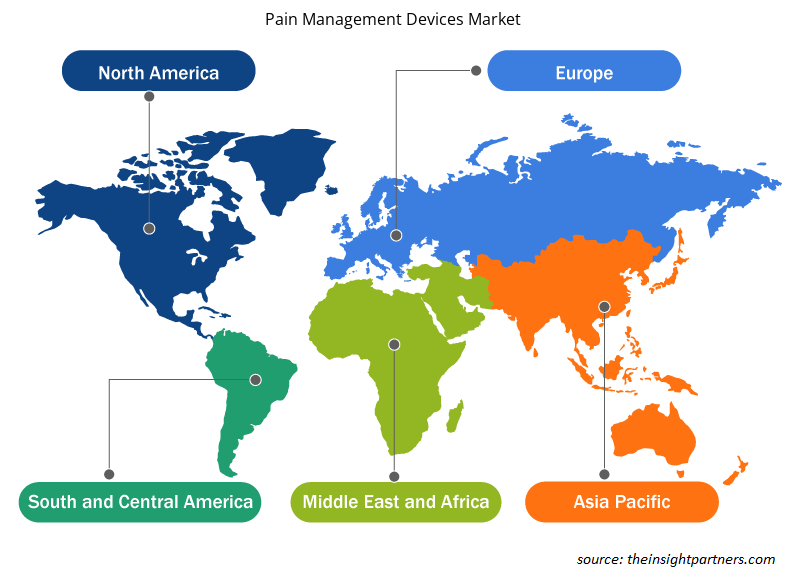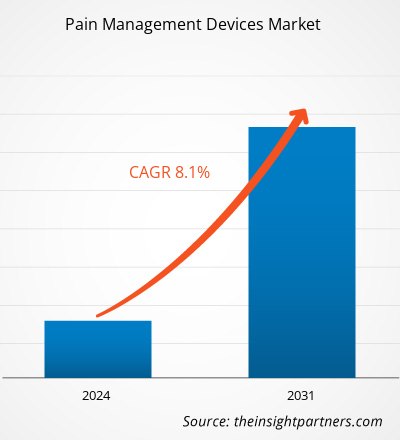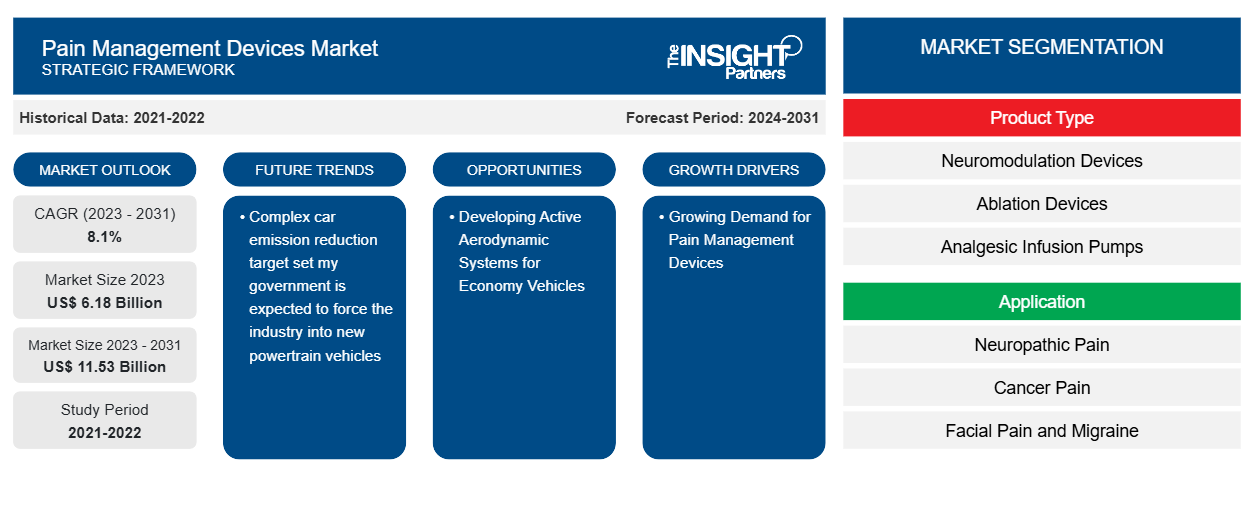Der Markt für Schmerztherapiegeräte wurde 2023 auf 6,18 Milliarden US-Dollar geschätzt und soll bis 2031 11,53 Milliarden US-Dollar erreichen. Der Markt soll in den Jahren 2023–2031 eine durchschnittliche jährliche Wachstumsrate von 8,1 % verzeichnen. Der technologische Fortschritt wird wahrscheinlich weiterhin der Schlüssel zu den Markttrends für Schmerztherapiegeräte sein.
Marktanalyse für Schmerztherapiegeräte
Schmerztherapiegeräte werden zur Kontrolle oder Behandlung von Schmerzen eingesetzt, die durch Krebsbehandlungen, Arthritis und alte Verletzungen verursacht werden. In Krankenhäusern werden je nach Schmerzintensität des Patienten Geräte verwendet, die rezeptfrei erhältlich sind oder während der Schmerztherapie eingesetzt werden können. Schmerztherapiegeräte werden bei der Implantation, dem Ersatz oder anderen chirurgischen Eingriffen eingesetzt, bei denen ein Gerät zur Schmerzbehandlung eingesetzt wird. Zur Behandlung von Nervenschmerzen und Brustschmerzen infolge einer koronaren Herzerkrankung werden Infusionspumpen oder Neurostimulatoren eingesetzt. Die alternde Bevölkerung, die steigende Zahl neuer Produkteinführungen und die zunehmende Zahl chronischer Schmerzen tragen alle zur anhaltenden Nachfrage nach Schmerztherapiegeräten bei.
Marktübersicht für Schmerztherapiegeräte
Der Markt für Schmerztherapiegeräte ist in den letzten Jahren aufgrund der zunehmenden Häufigkeit chronischer Schmerzzustände und des technologischen Fortschritts deutlich gewachsen. Der Markt umfasst viele Geräte, wie Analgetika-Infusionspumpen, Neurostimulatoren und Elektrostimulationsgeräte. Nordamerika und Europa dominieren den Markt für Schmerztherapiegeräte, aber auch die Schwellenmärkte in Lateinamerika und im asiatisch-pazifischen Raum wachsen schnell. Abbott Laboratories, Boston Scientific Corporation, Medtronic und andere große Akteure sind auf dem Markt. Der Markt ist durch ständige Innovation gekennzeichnet, da Unternehmen Forschung und Entwicklung betreiben, um wirksamere und minimalinvasive Schmerztherapielösungen auf den Markt zu bringen. Weitere wichtige Faktoren, die die Marktdynamik beeinflussen, sind Patientenpräferenzen, Erstattungsrichtlinien und behördliche Genehmigungen.
Passen Sie diesen Bericht Ihren Anforderungen an
Sie erhalten kostenlos individuelle Anpassungen an jedem Bericht, einschließlich Teilen dieses Berichts oder einer Analyse auf Länderebene, eines Excel-Datenpakets sowie tolle Angebote und Rabatte für Start-ups und Universitäten.
- Holen Sie sich die wichtigsten Markttrends aus diesem Bericht.Dieses KOSTENLOSE Beispiel umfasst eine Datenanalyse von Markttrends bis hin zu Schätzungen und Prognosen.
Markttreiber und Chancen für Schmerztherapiegeräte
Wachsende Nachfrage nach Schmerztherapiegeräten begünstigt den Markt
In Schmerztherapiegeräten werden viele Technologien und Techniken eingesetzt, um Schmerzen zu lindern oder zu kontrollieren. Transkutane elektrische Nervenstimulationsgeräte (TENS), gepulste elektromagnetische Felder (PEMF), Ultraschalltherapie und Infrarottherapiegeräte sind einige gängige Varianten. Jedes Gerät funktioniert nach unterschiedlichen Prinzipien und kann bei einer Reihe von Schmerzsituationen hilfreich sein, von akuten Verletzungen bis hin zu Langzeiterkrankungen. Für viele Erwachsene in den Vereinigten Staaten sind chronische Schmerzen ein lähmender Zustand, der sie bei täglichen Aktivitäten wie Arbeit und Leben beeinträchtigt. Die Centers for Disease Control and Prevention schätzen, dass im Jahr 2021 5,1 % (17,1 Millionen Menschen) bzw. 20,9 % (51,6 Millionen Erwachsene) der amerikanischen Erwachsenen an chronischen Schmerzen bzw. starken chronischen Schmerzen leiden. Daher werden eine steigende Zahl von Patienten mit chronischen Schmerzen und das Bewusstsein für die Tragbarkeit, Sicherheit, Wirksamkeit und Benutzerfreundlichkeit von Schmerztherapiegeräten wahrscheinlich die Nachfrage ankurbeln. Dies führt zum Wachstum des Marktes.Transcutaneous electrical nerve stimulation (TENS) units, pulsed electromagnetic field (PEMF) devices, ultrasound therapy, and infrared therapy devices are a few common varieties. Every gadget functions according to distinct principles and could be helpful for a range of pain situations, from acute injuries to long-term illnesses. For many adults in the United States, chronic pain is a paralyzing condition that interferes with daily activities such as work and life. The Centers for Disease Control and Prevention estimate that in 2021, 5.1% (17.1 million people) and 20.9% (51.6 million adults) of American adults suffer from chronic pain and high-impact chronic pain, respectively. Thus, an increase in the number of patients with chronic pain and awareness regarding the portability, safety, effectiveness, and ease of use of pain management devices will likely drive the demand. This leads to drives the growth of the market.
Einführung neuer Produkte – eine Chance auf dem Markt für Schmerztherapiegeräte
Neurostimulationsgeräte zur Behandlung chronischer Schmerzen sind durch Fortschritte im medizinischen Bereich möglich geworden. Zahlreiche Unternehmen, darunter Abbott, Medtronic und Omron Healthcare, Inc., haben Neurostimulationstechnologie eingeführt. Wichtige Akteure haben auch der Neurostimulationstherapie ihre Aufmerksamkeit zugewandt. In den letzten Jahrzehnten hat sich die Neurostimulation von einer Technik mit niedriger Auflösung zu einer hochentwickelten Methode entwickelt, die modernste Technologien nutzt. Zahlreiche neurologische Anwendungen der Neurostimulation wurden getestet; die Ergebnisse sind sehr vielversprechend, und die Branche beginnt, diesem aufstrebenden Bereich mehr Aufmerksamkeit zu schenken. Zahlreiche medizinische Technologien verwenden Neurostimulation, und einige dieser Geräte haben bereits die Zulassung für den klinischen Einsatz erhalten. Die Entwicklung der Neurostimulation folgte Entwicklungen in anderen Bereichen. Die schnelle Entwicklung des Bereichs wurde durch die Einführung neuer Technologien unterstützt, darunter flexible Elektronik, anwendungsspezifische integrierte Schaltkreistechnologie (ASIC), drahtlose Energieübertragung und Silizium-Mikrofabrikation, um nur einige zu nennen. Die Neurostimulationstherapie ist eine Spitzentechnologie, die in Zukunft größere Wachstumsaussichten haben dürfte. Im Januar 2024 wurden positive Langzeitergebnisse aus der randomisierten kontrollierten COMFORT-Studie (RCT) des peripheren Nervenstimulationsgeräts (PNS) des kalifornischen Unternehmens Nalu Medical zur Behandlung chronischer Schmerzen veröffentlicht. Das Neurostimulationssystem von Nalu wird in der randomisierten kontrollierten COMFORT-Studie (RCT) zur Behandlung von Fuß-, Knöchel-, Schulter- und Rückenschmerzen getestet. Im März 2021 wurde ein nicht-invasives mehrkanaliges Hirnneuromodulationssystem zur Behandlung akuter Migräne zugelassen. devices for the treatment of chronic pain have been made possible by advancements in the medical field. Numerous businesses, including Abbott, Medtronic, and Omron Healthcare, Inc., have introduced neurostimulation technology. Key players have also turned their attention to neurostimulation therapy. Over the past few decades, neurostimulation has advanced from a low-resolution technique to a highly sophisticated methodology utilizing cutting-edge technologies. Numerous neurological applications of neurostimulation have been tested; the results show great promise, and the field is beginning to pay more attention to this emerging field. Numerous medical technologies use neurostimulation, and some of these devices have already received approval for clinical use. The development of neurostimulation followed developments in other fields. The field's rapid development was aided by adopting emerging technologies, including flexible electronics, application-specific integrated circuit (ASIC) technology, wireless energy transfer, and silicon microfabrication, among many others. Neurostimulation therapy is a cutting-edge technology that should see greater growth prospects in the future. In January 2024, positive long-term results from the COMFORT randomized controlled trial (RCT) of California-based Nalu Medical's peripheral nerve stimulation (PNS) device for treating chronic pain have been released. The Nalu neurostimulation system is being tested in the COMFORT randomized controlled trial (RCT) to treat foot, ankle, shoulder, and lower back pain. A non-invasive multi-channel brain neuromodulation system was approved in March 2021 to treat acute migraines.
Marktbericht zu Schmerztherapiegeräten – Segmentierungsanalyse
Wichtige Segmente, die zur Ableitung der Marktanalyse für Schmerzbehandlungsgeräte beitragen, sind Produkttyp und Anwendung.
- Based on therapy type, the pain management devices market is segmented into neuromodulation devices, ablation devices, analgesic infusion pumps. The neuromodulation devices segment held a larger market share in 2023.
- By application, the market is segmented into neuropathic pain, cancer pain, facial pain and migraine, musculoskeletal pain, others. The neuropathic pain segment held the largest share of the market in 2023.
Pain Management Devices Market Share Analysis by Geography
The pain management devices market report's geographic scope is divided into five regions: North America, Asia Pacific, Europe, Middle East & Africa, and South America/South & Central America.
North America has dominated the pain management devices market. In North America, the U.S. is the largest market for pain management devices in 2023. Well-established healthcare infrastructure, the presence of key players and healthcare facilities, and early adoption of technologically advanced products are the factors that likely contribute to the region's market growth. For instance, in November 2021, the FDA granted de novo approval for AppliedVRx, its flagship immersive therapeutic, to treat chronic low back pain. EaseVRx was previously designated as a breakthrough device in 2020. AppliedVR is a pioneer in advancing the next generation of immersive therapeutics. With preloaded software content on a proprietary hardware platform, EaseVRx is a prescription-only medical device that offers pain management training based on cognitive behavioral skills and other behavioral methods.
Pain Management Devices Market Regional Insights
The regional trends and factors influencing the Pain Management Devices Market throughout the forecast period have been thoroughly explained by the analysts at Insight Partners. This section also discusses Pain Management Devices Market segments and geography across North America, Europe, Asia Pacific, Middle East and Africa, and South and Central America.

- Get the Regional Specific Data for Pain Management Devices Market
Pain Management Devices Market Report Scope
| Report Attribute | Details |
|---|---|
| Market size in 2023 | US$ 6.18 Billion |
| Market Size by 2031 | US$ 11.53 Billion |
| Global CAGR (2023 - 2031) | 8.1% |
| Historical Data | 2021-2022 |
| Forecast period | 2024-2031 |
| Segments Covered | By Product Type
|
| Regions and Countries Covered | North America
|
| Market leaders and key company profiles |
|
Market Players Density: Understanding Its Impact on Business Dynamics
The Pain Management Devices Market market is growing rapidly, driven by increasing end-user demand due to factors such as evolving consumer preferences, technological advancements, and greater awareness of the product's benefits. As demand rises, businesses are expanding their offerings, innovating to meet consumer needs, and capitalizing on emerging trends, which further fuels market growth.
Market players density refers to the distribution of firms or companies operating within a particular market or industry. It indicates how many competitors (market players) are present in a given market space relative to its size or total market value.
Major Companies operating in the Pain Management Devices Market are:
- Medtronic plc
- ST. Jude Medical, Inc
- Boston Scientific Corporation
- Hospira, Inc
- Halyard Health Inc
- Smiths Medical
Disclaimer: The companies listed above are not ranked in any particular order.

- Get the Pain Management Devices Market top key players overview
Pain Management Devices Market News and Recent Developments
The Pain Management Devices market is evaluated by gathering qualitative and quantitative data post primary and secondary research, which includes important corporate publications, association data, and databases. The following is a list of developments in the market for pain management devices and strategies:
- Boston Scientific Corporation announced the close of its acquisition of Relievant Medsystems Inc., a company that offers the only U.S. Food and Drug Administration-cleared IntraceptIntraosseous Nerve Ablation System, a therapy to treat vertebrogenic pain that is a form of chronic low back pain (Source: Boston Scientific Corporation Company Name, Newsletter, 2023)
- Nevro Corp., a global medical device company that is delivering comprehensive, life-changing solutions for the treatment of chronic pain, announced that it has acquired Vyrsa Technologies, a privately held medical technology company focused on a minimally invasive treatment option for patients suffering from chronic sacroiliac joint pain. (Source: NEVRO CORP Company Name, Press Release, 2023)
Pain Management Devices Market Report Coverage and Deliverables
The “Pain Management Devices Market Size and Forecast (2021–2031)” report provides a detailed analysis of the market covering below areas:
- Market size and forecast at global, regional, and country levels for all the key market segments covered under the scope
- Market dynamics such as drivers, restraints, and key opportunities
- Key future trends
- Detailed PEST/Porter’s Five Forces and SWOT analysis
- Global and regional market analysis covering key market trends, major players, regulations, and recent market developments
- Industry landscape and competition analysis covering market concentration, heat map analysis, prominent players, and recent developments
- Detailed company profiles
- Historische Analyse (2 Jahre), Basisjahr, Prognose (7 Jahre) mit CAGR
- PEST- und SWOT-Analyse
- Marktgröße Wert/Volumen – Global, Regional, Land
- Branchen- und Wettbewerbslandschaft
- Excel-Datensatz
Aktuelle Berichte
Verwandte Berichte
Erfahrungsberichte
Grund zum Kauf
- Fundierte Entscheidungsfindung
- Marktdynamik verstehen
- Wettbewerbsanalyse
- Kundeneinblicke
- Marktprognosen
- Risikominimierung
- Strategische Planung
- Investitionsbegründung
- Identifizierung neuer Märkte
- Verbesserung von Marketingstrategien
- Steigerung der Betriebseffizienz
- Anpassung an regulatorische Trends





















 Kostenlose Probe anfordern für - Markt für Schmerzbehandlungsgeräte
Kostenlose Probe anfordern für - Markt für Schmerzbehandlungsgeräte